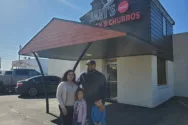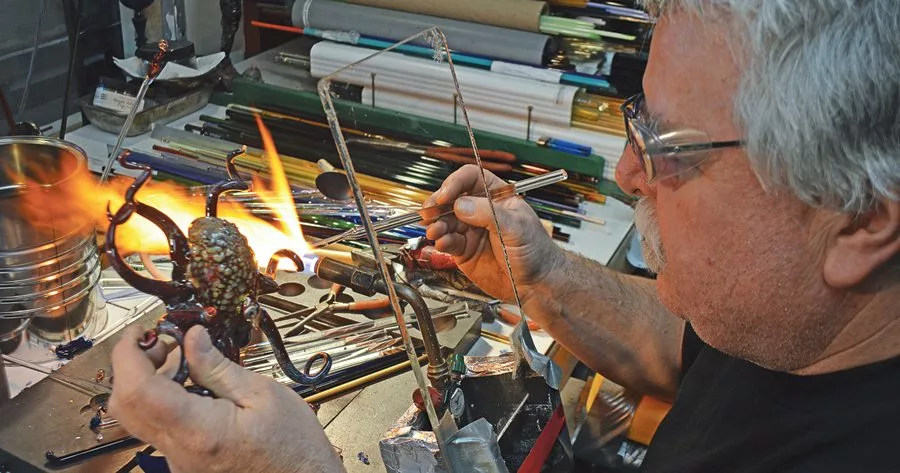
Home » Longtime glass artist opens gallery in downtown Benton City
Longtime glass artist opens gallery in downtown Benton City

May 16, 2018
Few people can say their career took off by making unicorns.
Paul Labrie credits the thousand or so sculpted glass unicorns he made while in college to help cover his school expenses until he began working full time as a glass artist. Today, his work is featured in galleries across the country.
Labrie, 60, recently opened Labrie Glass Studios in downtown Benton City, providing customers an opportunity to see his gallery or blow their own glass. The studio held a grand opening in April.
“People are surprised when they come into Benton City and they find a glass blower. I think they’re appreciative of the fact that there’s an artist in town,” he said.
Labrie said he is ready for his first full season of wine tourism. The studio isn’t far from many of the popular wineries on Red Mountain.
“Benton City isn’t really a destination; it’s more of an offshoot. People come here for the wines, so my studio is part of the opportunity to develop businesses that tie into that,” Labrie said.
Labrie is the namesake of Labrie Glass Studios, on Ninth Street in a building rented from the Port of Benton. He has been a glass artist since the mid-70s, when he left college to pursue the art.
His start in glass blowing came when he got a job out of high school in the shipping and packing department at a scientific glass-blowing shop in California that made chemical lab apparatuses, describing the items as “monster movie kind of stuff.”
The company needed a worker to relocate to Texas, but none of the employees wanted to move. Labrie agreed to take the job if he could learn the glass-blowing trade, and 40 years later it remains his profession.
Labrie has made numerous moves in the meantime, selling his handmade creations at art shows, in catalogs and through contracts with large companies like Merrill Lynch and FedEx.
“A lot of my work is the whole corporate premium incentive awards. You know, the stuff you get and you put in the closet,” he joked.
Labrie said his claim to fame was having one of his glass Merrill Lynch bulls appear in the company’s annual Super Bowl commercial.
“They have the bulls running down Main Street and everything’s shaking and one of my pieces knocked off the shelf,” Labrie said.
He hadn’t been notified ahead of time that his art was going to be featured and saw the commercial for the first time along with the rest of the viewers. “I had to call my mom, of course,” Labrie said.
Labrie’s dry wit and humble nature is apparent as his studio was once called Blow Hard Glass. He meant it in a comedic way, but found customers took the name the wrong way, and so he now does business as Labrie Glass Studios.
Humor is present in many of his pieces, and it’s evident Labrie doesn’t take himself too seriously. A lot of his glass designs feature animals or anthropomorphism, such as pigs that fly, artichokes as people or a piece called, “When Dragonflies go Bad,” which features a dragonfly that has stolen the pants of a glass man.
“People laugh when they suddenly realize it’s anatomically correct,” Labrie said.
Despite the creative pieces, lampworking for his wholesale line is what pays the bills. Lampworking is the kind of intricate sculpting work done with a torch instead of in an oven. Labrie ships out 90 percent of his work, which include a lot of Northwest-focused aquatic designs, like whales, seals and octopi.
He said about half his orders are for corporate customers.
Labrie’s work is featured in 14 galleries around the country, including the Museum of Glass in Tacoma. His designs can also be found in catalogs like “Artful Home.”
It’s a long way from Labrie’s early days, creating unicorns during the ’70s when glass as an art form was at its height.
“Glass was appreciated much more than it is now. It doesn’t have the same cachet it used to have,” he said. “Back then, everything I made, I sold. So it was an income stream that I could use to easily pay my bills.”
Labrie said the popularity of glass was almost “too easy” and so he left college before finishing his oceanography degree.
The first place Labrie sold his art was at a clothing store in Northern California, which let him set up a table and a torch in the middle of the lingerie section during Christmastime.
Labrie laughed at the inherent liability risk it was to allow an open flame around flammable merchandise.
“It was a different time,” he said.
He also remembered how customers would stand and watch him for two hours straight, which is nearly unheard of today. “People don’t have that kind of attention span anymore,” he said.
It takes about 15 minutes to create a small, handheld piece, like the unicorns, but can take hours for a larger, more sophisticated item.
Customers who visit his Benton City studio for a glass-blowing class can expect to spend about an hour going over safety and creating a simple piece, like a paperweight, float or heart.
“Glass blowing is the form that really captures people’s imagination,” Labrie said.
Labrie previously ran a studio and gallery in Port Angeles.
“Since we didn’t see the sun for eight years, we moved to the Tri-Cities, and now we haven’t seen the rain for eight years,” he said.
He quietly kept studio space in Benton City for three years prior to opening the Ninth Street shop, but it wasn’t a retail business with a gallery.
Having a location downtown “gives me an opportunity to mingle with people,” Labrie said. Running the retail side of his business has never been his passion, so Labrie had his three daughters selling his art beginning when they were as young as 5. Now, those daughters are grown up, yet one remains in the glass industry in the Seattle area, where there are fewer studios than the city once enjoyed.
“That whole (Interstate) 5 corridor used to have more glass blowers per capita than any other place in the world. More than Murano, (Italy), or other locations known for glass-blowing. There were hundreds of glass-blowing studios, like mine, in the I-5 corridor because of Dale Chihuly and the Pilchuk Glass School, but it’s become more difficult for people to maintain the one-man glass-blowing studio. It’s just that times change, so Benton City seemed like a good place,” he said.
Labrie’s studio shares a building with Branches and Vines country store across from the former site of City Hall.
For those looking to blow their own glass, a single item costs $85, with each additional item costing $55, which also counts toward pieces made by a group.
Labrie Glass Studios: 713 Ninth St., Ste. B, Benton City; 509-362-4040; labrieglass.com. Gallery hours are from 11 a.m.-4 p.m. Wednesday-Saturday. Blow your own glass is by appointment.
Local News Hospitality & Meetings
KEYWORDS may 2018





